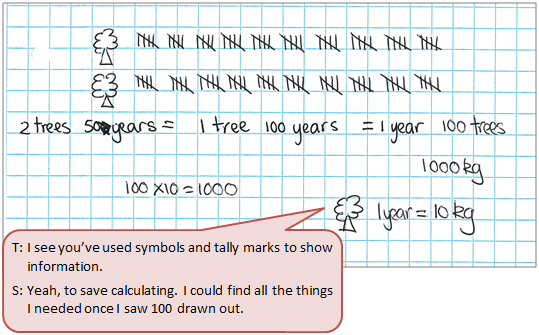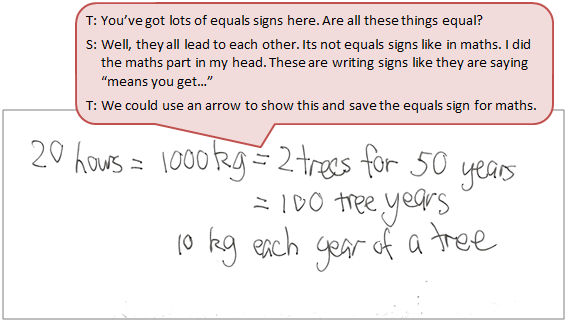The purpose of this activity is to engage students in using mathematical strategies and knowledge of basic facts, to solve a problem in context.
This activity assumes the students have experience in the following areas:
- Recalling basic multiplication facts.
- Finding unknown values in problems with rates.
- Identifying the important information in word problems.
The problem is sufficiently open ended to allow the students freedom of choice in their approach. It may be scaffolded with guidance that leads to a solution, and/or the students might be given the opportunity to solve the problem independently.
The example responses at the end of the resource give an indication of the kind of response to expect from students who approach the problem in particular ways.

The average person in New Zealand travels by air for a total of 20 hours per year. This equates to 1000 kg of carbon added to the atmosphere by each person, each year.
A green initiative suggests that if everyone planted two trees a year, this will offset the carbon from air travel.
Assuming the average lifespan of a tree is 50 years, how much carbon does each tree offset, each year?
The following prompts illustrate how this activity can be structured around the phases of the Mathematics Investigation Cycle.
Make sense
Introduce the problem. Allow students time to read it and discuss in pairs or small groups.
- Do I understand the situation and the words? (There a many contextual aspects to the problem. Students will need support understanding how aviation emits carbon, what is meant by ‘on average’, and how trees store carbon by photosynthesis.)
- What are the important words and symbols? (The meaning of kg as kilogram is important, as is the concept of rates such as 20 hours per year, and 1000 kg per person per year.)
- Do I have all the information I need? Is any information missing? (Students might want to look up the latest advice about offsetting carbon emissions.)
- What will my solution look like? (The solution will calculate the amount of carbon offset by one tree each year, supported by reasoning.)
Plan approach
Discuss ideas about how to solve the problem. Emphasise that, in the planning phase, you want students to say how they would solve the problem, not to actually solve it.
- What are the maths skills I need to work this out? (Students need to identify the problem as involving rates and recall the useful strategies for solving rate problems. Since rates usually involve measures students need to identify the key attributes (weight and time) and the units those attributes are measured in.)
- What could the solution be? What is a sensible estimate?
- What could the solution definitely not be?
- What strategies are likely to be useful? (Ratio/rate tables are useful in organising the information.)
- How could I show this problem using numbers, pictures, graphs, tables, or materials?
- What tools (digital or physical) could help my investigation? (Calculators may be useful but are not essential.)
Take action
Allow students time to work through their strategy and find a solution to the problem.
- Does my recording support me to see any patterns?
- Is there another possible answer or way to solve it?
- Are there any patterns?
- How might I describe the patterns?
- Is my strategy working or should I try another strategy?
- Am I calculating using the most efficient operations? (Multiplication and division are essential for efficient working with rates.)
- Does my solution make sense? Does it match my estimation?
- Does my solution answer the question?
Convince yourself and others
Allow students time to check their answers and then either have them pair share with other groups or ask for volunteers to share their solution with the class.
- What is the solution? Does the solution make sense?
- Is my working clear for someone else to follow?
- How would I convince someone else I am correct?
- Could I have solved the problem in a more efficient way?
- Would my strategy work in a different situation? What kinds of situations will my strategy work for?
- Which ideas or tools worked well in my problem solving?
- What could I try differently next time?
- Is there some maths I need to learn?
Examples of work
Work sample 1
The student solves a context-based rates problem, using diagrams and multiplicative strategies with some guidance.
Click on the image to enlarge it. Click again to close.
Work sample 2
The student solves a context-based rates problem, using equations and multiplicative strategies independently.

